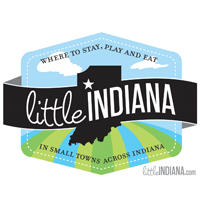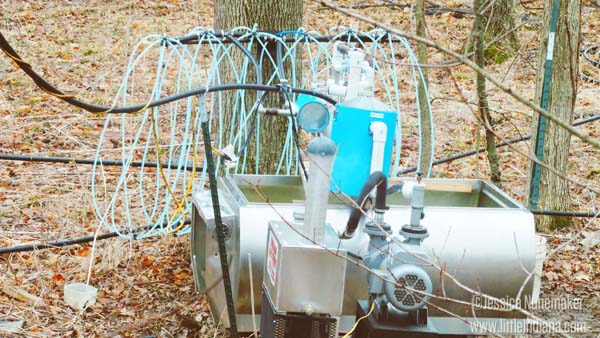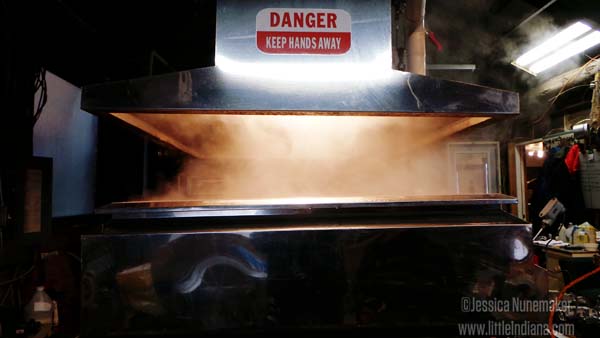From the last week of January to the first week of March (more or less), Harris Sugar Bush in Greencastle, Indiana works almost unceasingly!
They have a limited amount of time to tap the maple trees on their property, so someone is always working during the season. When does the maple syrup season end? The season ends when the evenings aren’t consistently cold enough to freeze.
Harris Sugar Bush in Greencastle, Indiana
I have been to farms before, yes, but I have never been to a farm where they tapped the trees to make maple syrup! I couldn’t wait to show our boys. I knew they would find it interesting.
It was almost otherworldly, driving down the long, long driveway to get to the farm. I only got slightly turned around but that’s nothing new. The drizzly weather I experienced probably didn’t help much! Rainy as it was, the property is wonderful! There are trees everywhere with hills here and there.
But we saw something that let us know we weren’t on just any kind of farm. Blue tubes were strung from tree to tree, flowing down to a central source. There are thirty miles of blue tubing here–and roughly 6,000 taps! You can see what that looked like in the image above. It wasn’t exactly close to us–I had to use the zoom function on my camera to get all up close and personal with it. It was really something to see! How did this work? We were getting ready to find out!
Greencastle, Indiana Maple Syrup Farm
First, remember that blue tubing all over the place, running from tree to tree? Unlike the old days, when tubes would need frequent replacing due to brittleness, today’s tubes last much longer. The biggest problem are the squirrels! Every maple tree is tapped and the blue tubing heads to a collection tank. You see, our Indiana nights aren’t exactly warm in the winter. Those cold 25-28* evenings make the cells contract, form a vacuum, and suck groundwater in the tree. When the morning sun shines on the tree, these cells then expand, causing CO2 to pressurize the tree–and the sap begins to flow!
I asked what would happen if it was much colder. The whole process stops! It won’t begin again until it warms up and thaws out. Sometimes it can extend the season a bit and that is what they really hope for.
A 400 gallon milk cooler in its past life, the collection tank has obviously been modified and is well-suited for its new purpose: sap collection! Even with what I would consider a large capacity, the tank must still be emptied out between one and three times a day. It takes 40-50 gallons of sap to make just one gallon of maple syrup.
Making Maple Syrup
We headed into the cabin and browsed the Indiana maple syrup and food items for sale until someone could show us the farm. What a farm it is! There’s a lot of work to be done and we got right in there to see where the maple magic happens.
The sugar house, where the sap is boiled, was made from materials on the farm. There’s a mix of old and new here to keep things running as smoothly as possible. Vintage copper pans are still used along with an oil-fired evaporator. What is an evaporator? After all the extra water is taken out, the sap heads into the evaporator. It’s just a fancy way of saying that the extra water keeps getting boiled away or, you know, evaporated! This is a hard-working piece of equipment capable of processing 2,000 gallons of maple syrup in just one day!
You might be able to guess what happens next. The image above is a good clue! After the evaporator, the syrup will be heated to a toasty 221*. But to reach that point, the furnace needs to fire at 2100* in order to become the finished product that you see nicely bottled and ready for sale in their cute little cabin.
There, the syrup is organized by grade. In the United States, there are only two grades: Grade A and Grade B. Grade A is the product that you would pour over your favorite pancake recipe or drizzle over french toast. Grade A has three sub-grades: light amber, medium amber, and dark amber. These variations depend on the coloring or, really, the translucence of the syrup. Grade B is mostly used only when cooking and baking.
Go There
If you can’t make it to see everything in action, you are always welcome to take a tour (and pick up maple syrup) year round. Please make sure to call ahead to set up an appointment.
Small Towns: Destinations, not Drive-Thrus! I’m Jessica Nunemaker and THIS is little Indiana!
Just don’t forget to tell ’em that little Indiana sent you!
Harris Sugar Bush
999 East County Road 325 North
Greencastle, IN 46135
765.653.5108
Targeted. Relevant. Affordable! little Indiana advertising.




